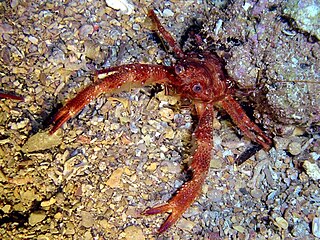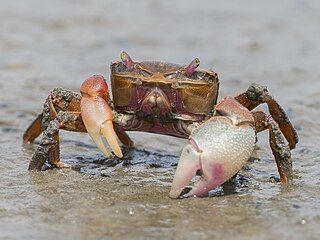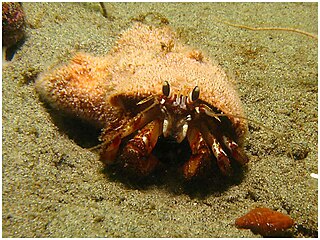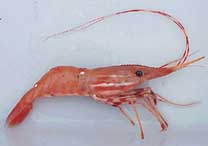 W
WCardisoma armatum is a species of terrestrial crab.
 W
WThe purple shore crab, Hemigrapsus nudus, is a common crab of the family Varunidae. It can be found sheltering under rocks in inter-tidal areas along the west coast of North America, from Alaska to Baja California in Mexico. This crab primarily eats sea lettuce and other green algae, and occasionally scavenges dead animals.
 W
WDiscoplax hirtipes is a species of terrestrial crab.
 W
WGalathea intermedia is a species of squat lobster found in the north-eastern Atlantic Ocean, as far north as Troms, Norway, south to Dakar and the Mediterranean Sea.
 W
WHemigrapsus oregonensis is a small shore crab of the family Varunidae; it was formerly classified under the family Grapsidae. It is known under several common names, including yellow shore crab, hairy shore crab, green shore crab, mud-flat crab, and Oregon shore crab.
 W
WMegalorchestia californiana is a species of sand-hopper in the family Talitridae. It was first described in 1851 by the German naturalist Johann Friedrich von Brandt and is the type species of the genus Megalorchestia. It is commonly known as the long-horned beach hopper.
 W
WMicrophrys weddelli is a species of crab in the family Majidae.
 W
WNeohelice granulata is a species of crab in the family Varunidae, and the only species in the genus Neohelice. In 2009, it was estimated that N. granulata was the sixth most studied species of crab.
 W
WOregonia gracilis, commonly known as the graceful decorator crab, is a species of crab belonging to the family Oregoniidae. Like other decorator crabs it habitually attaches other organisms to its back. The sessile organisms are attached to hooked setae that act as a sort of velcro attachment. This decoration provides visual and chemical camouflage thus reducing predation risk. Pacific halibut are a major predator of O. gracilis. Other predators include octopus and sea otters. The main food source of O. gracilis is floating kelp and algae that they capture utilizing a waiting strategy in order to maintain cryptosis.
 W
WPagurus armatus, the armed hermit crab or black-eyed hermit crab, is a species of hermit crab found in the eastern Pacific Ocean of the United States and British Columbia, Canada.
 W
WPagurus hirsutiusculus is a species of hermit crab, commonly called the hairy hermit crab. It lives from the Bering Strait south to California and Japan, from the intertidal zone to a depth of 110 m (360 ft).
 W
WPandalus hypsinotus is a crustacean in the Pandalidae family, ordinarily 10–12.5 centimetres (3.9–4.9 in) in length, but large females may reach 17.5 centimetres (6.9 in). It can be found in the Bering Sea, from the Aleutian Islands to Puget Sound, and in the Sea of Japan at depths of 100–200 metres (330–660 ft).
 W
WPandalus platyceros, also called California spot prawn or Alaskan prawn, is a shrimp of the genus Pandalus.
 W
WParalithodes platypus, the blue king crab, is a species of North Pacific king crab which lives near St. Matthew Island, the Pribilof Islands, and the Diomede Islands, Alaska, with further populations along the coasts of Japan and Russia. Although blue king crabs are among the largest crabs in the world and reputedly may exceed 18 pounds (8.2 kg) in weight, they are generally smaller than red king crabs.
 W
WPentidotea wonsnesenskii is a marine isopod which lives on seaweed on rocky shores along the British Columbia and Washington coastlines, as far south as San Francisco. It can be as large as 40 millimetres (1.6 in) long, with a concave tail rather than an indented tail as previously shown on this page, is usually green, but its colour is adaptable to its environment. It can often be found hiding under rockweed in the intertidal zone. It is named after the Russian biologist Ilya G. Voznesensky.
 W
WPugettia gracilis, commonly known as the graceful kelp crab, is a species of small crab in the family Epialtidae. It lives among forests of kelp on the Pacific coast of North America.
 W
WSagmariasus verreauxi is a species of spiny lobster that lives around northern New Zealand, the Kermadec Islands the Chatham Islands and Australia from Queensland to Tasmania. It is probably the longest decapod crustacean in the world, alongside the American lobster Homarus americanus, growing to lengths of up to 60 centimetres (24 in).
 W
WThe tunnelling mud crab, Austrohelice crassa, is a marine large-eyed crab of the family Grapsidae, endemic to the sea coasts of New Zealand. Their carapace width is up to 40 mm.